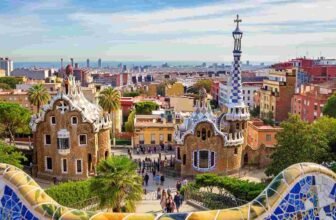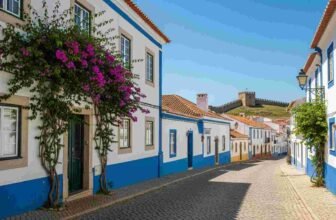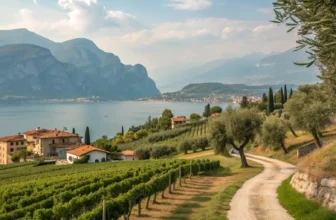
Gas prices creeping up again? You’re not alone in feeling like every getaway now comes with a hefty price tag. But here’s a secret most travel sites won’t tell you: some of the most jaw-dropping adventures in the U.S. are still within reach — even on a tight budget.
We’re talking open roads, soul-stirring views, and that rare sense of freedom that doesn’t drain your wallet. These aren’t just affordable trips — they’re the kind you’ll talk about for years. So, if $500 is your limit, don’t worry. We’ve got twelve stunning routes that’ll take you far without taking it all.
1. Blue Ridge Parkway – North Carolina to Virginia

Tucked into the Appalachian Highlands, the Blue Ridge Parkway is often called “America’s Favorite Drive,” and once you’re on it, you’ll see why. This 469-mile ribbon of road winds through lush forests, panoramic overlooks, and charming mountain towns. Gas is your biggest cost here—and even that is manageable thanks to the parkway’s slow pace and low elevation gain.
What makes it budget-friendly is the sheer number of free or low-cost activities along the way. From hiking trails that lead to hidden waterfalls to stopping at visitor centers filled with cultural exhibits, it’s easy to fill your days without draining your wallet. Bonus: There are no tolls on the entire parkway, and many campsites and motels along the way cater to budget travelers.
Autumn is pure magic here. The vibrant reds, oranges, and golds of the fall foliage feel surreal as you drive with the windows down, cool breeze coming in, and folk music on the radio. But spring’s blooming rhododendrons or summer’s warm sunshine through the trees are just as captivating.
Quick Tips & Info:
- Best Months to Visit: Late September to early November (fall colors) or May–June (spring bloom)
- Ideal Trip Length: 3–4 days
- Main Costs: Gas, budget motels ($60–90/night), camping (even cheaper)
- Top Free Stops: Craggy Gardens, Mabry Mill, Linville Falls, Blue Ridge Music Center
- Pro Tip: Pack a cooler and picnic — scenic pull-offs are made for it
2. Pacific Coast Highway – California (Big Sur to San Luis Obispo)

Few drives in the world compete with the rugged beauty of California’s Pacific Coast Highway, particularly the stretch between Big Sur and San Luis Obispo. Waves crash against cliffs, whales surface offshore, and the horizon stretches endlessly ahead. Even a weekend here feels like a soul cleanse.
This route is easily done on a $500 budget, especially if you start from a nearby city like San Francisco or Los Angeles. Drive slowly (literally — the curves won’t let you go fast) and soak in each jaw-dropping vista. Pack a tent if you want to wake up to the sound of the ocean. Or split a no-frills roadside motel with a friend for that classic California road trip feel.
State parks like Julia Pfeiffer Burns and Limekiln offer $10–$15 parking and some of the most photogenic trails in the country. You’ll spot waterfalls that spill directly into the sea and cliffs that look like they were carved for movie scenes — because many were.
Quick Tips & Info:
- Best Months to Visit: April–June or September–October (fewer crowds, mild weather)
- Ideal Trip Length: 2–3 days
- Main Costs: Gas, camping ($35 or less), food (grab groceries en route)
- Top Free Stops: Bixby Creek Bridge, McWay Falls, Elephant Seal Rookery
- Pro Tip: Avoid weekends for smoother drives and easier parking
3. Route 100 – Vermont Fall Foliage Drive

If autumn is your season, Route 100 in Vermont is your dream road trip. This scenic byway threads through charming villages, covered bridges, rolling farmland, and — in fall — some of the most stunning foliage in the world. You’ll swear someone turned up the saturation in real life.
The drive is surprisingly affordable, especially if you base out of one small town and make day trips from there. Airbnbs or cozy inns in places like Stowe, Ludlow, or Weston often have off-season deals in early fall. And many of the best experiences — cider mills, covered bridge photo ops, local farm stands — cost little to nothing.
This route is all about slowing down and absorbing the details: the smell of fresh maple syrup, the crispness in the air, the handmade signs for apple pies and pumpkins. It’s the kind of trip that feels nostalgic even if it’s your first time.
Quick Tips & Info:
- Best Months to Visit: Late September through mid-October (peak foliage)
- Ideal Trip Length: 2–4 days
- Main Costs: Lodging (look for midweek or shoulder-season rates), gas
- Top Free Stops: Moss Glen Falls, Warren Store, Vermont Country Store
- Pro Tip: Bring your snacks and thermos — you’ll want to stop and linger often
4. Million Dollar Highway – Colorado (Silverton to Ouray)

Don’t let the name scare your wallet. The Million Dollar Highway, a 25-mile stretch of U.S. Route 550 in southwestern Colorado, offers million-dollar views for next to nothing. Carved into dramatic cliffs and flanked by soaring peaks, this route between Silverton and Ouray feels like something out of a fantasy film.
The road itself is free to drive, and the surrounding San Juan Mountains provide a playground of free hikes, old mining towns to explore, and pull-offs where the air alone feels worth the trip. You can spend two or three days bouncing between Silverton, Ouray, and Durango, all of which offer budget lodging or affordable campgrounds.
Even better? It’s one of those places where just driving is the experience. With towering cliffs on one side and plunging drops on the other, you’ll want to go slow — and not just for safety. Every twist in the road reveals a new vista that demands a photo stop.
Quick Tips & Info:
- Best Months to Visit: Late May to early October (road closures in winter)
- Ideal Trip Length: 2–3 days
- Main Costs: Gas, budget motels/cabins, campgrounds
- Top Free Stops: Red Mountain Pass, Bear Creek Falls, abandoned mining sites
- Pro Tip: Avoid night driving — there are no guardrails in some places
5. Going-to-the-Sun Road – Montana (Glacier National Park)

Driving the Going-to-the-Sun Road in Glacier National Park feels like you’re crossing into another world. This 50-mile alpine highway winds through jaw-dropping mountain passes, past glacial lakes, cedar forests, and wildflower meadows. It’s the kind of place where stopping the car every ten minutes is entirely justified.
Yes, Glacier is a national park, but if you’re strategic, you can experience it without blowing your budget. Campgrounds inside the park are affordable and scenic, and if you’re lucky enough to snag one, the views alone are worth it. Pack your food, buy a 7-day park pass, and you’ll still be under $500 even if you stretch the trip over 3–4 days.
The highlight? Logan Pass, where mountain goats often wander right past your car. Or maybe it’s Lake McDonald at sunset. Or that moment you see a glacier for the first time and realize how small and lucky you are to be there. This one’s for your soul.
Quick Tips & Info:
- Best Months to Visit: Mid-July through early September (when the road is fully open)
- Ideal Trip Length: 3–4 days
- Main Costs: Park pass ($35/car), gas, campground ($20–30/night)
- Top Free Stops: Logan Pass, Lake McDonald, Hidden Lake Trail
- Pro Tip: Reserve campsites in advance and download offline maps — cell service is minimal
6. Olympic Peninsula Loop – Washington

The Olympic Peninsula Loop is a road trip that wraps around a corner of the Pacific Northwest that most people only dream about. Starting in Port Angeles, this circular route gives you rainforests, coastline, alpine peaks, and lakes — all in one drive. And the best part? It’s entirely doable on a shoestring budget.
This trip is perfect for travelers who want a little bit of everything. You can go from hiking moss-draped trails in Hoh Rainforest, to skipping rocks on Lake Crescent, to watching surfers brave the cold Pacific at Rialto Beach. Olympic National Park does charge an entry fee, but the pass covers seven days — so you can stretch your stay without stretching your budget.
Accommodations can be kept affordable with camping or budget motels in Forks or Port Townsend. Even food can be easy if you grab groceries in a bigger town before starting the loop. Once you’re out there, you’re really out there — and that’s part of the magic.
Quick Tips & Info:
- Best Months to Visit: June through early September (drier, clearer trails)
- Ideal Trip Length: 3–4 days
- Main Costs: Park pass ($30/car), gas, budget motels or camping
- Top Free Stops: Hoh Rainforest trails, Ruby Beach, Hurricane Ridge viewpoint
- Pro Tip: Fill your tank before entering the park — gas is limited and pricey inside
7. Great River Road – Minnesota to Iowa Stretch

The Great River Road, which follows the path of the Mississippi River, is an underrated treasure — especially the stretch between Minnesota and Iowa. This route threads through quaint river towns, bluffs, wetlands, and farmland that glow with color in both spring and fall.
Budget travelers will love how easy it is to stop, explore, and enjoy without ever opening their wallets. Towns like Red Wing, Wabasha, and Decorah have free riverfront parks, scenic viewpoints, and charming downtowns with low-cost eats. If you’re into quirky Americana, this road is full of it — think river museums, historic bridges, and even bald eagle sanctuaries.
Because the route sticks close to the river, your gas consumption stays low. Many travelers also camp at state parks along the way, or opt for cozy mom-and-pop motels for under $80 a night.
Quick Tips & Info:
- Best Months to Visit: May–June or September–October
- Ideal Trip Length: 2–3 days
- Main Costs: Gas, low-cost lodging, local food
- Top Free Stops: Buena Vista Park overlook, Effigy Mounds National Monument, Pikes Peak State Park
- Pro Tip: Stop in towns on weekdays for fewer crowds and better prices on rooms
8. Outer Banks Scenic Byway – North Carolina

There’s something uniquely relaxing about a road that seems to float between sky and sea. That’s what the Outer Banks Scenic Byway offers. Spanning 138 miles, this coastal route includes ferries, barrier islands, and ocean views that go on forever. It’s a beach trip with a twist — and yes, it’s still totally doable for under $500.
Start around Nags Head or Kitty Hawk, and drive south through Cape Hatteras National Seashore. You’ll pass lighthouses, dunes, wild horses, and salt-swept marshes. Many of the beaches are free, and ferry rides are either free or cheap (the longer Hatteras–Ocracoke ferry is free; the Cedar Island ferry is around $15 per car).
If you bring camping gear or book ahead for off-season beach cabins, you’ll keep your costs down and your views up. This is the kind of place where slow mornings and salty air make the trip feel like a proper escape — without the high price tag of most beach vacations.
Quick Tips & Info:
- Best Months to Visit: April–June or September–October
- Ideal Trip Length: 3–4 days
- Main Costs: Gas, ferry (if applicable), basic lodging
- Top Free Stops: Cape Hatteras Lighthouse grounds, Pea Island Wildlife Refuge, beachcombing
- Pro Tip: Bring snacks and supplies — stretches of the drive have no stores for miles
9. San Juan Skyway – Colorado

The San Juan Skyway is a larger loop that includes the Million Dollar Highway, but if you have a few more days and still want to stay under budget, this trip is worth every twist and turn. The route passes through Ouray, Silverton, Durango, and Telluride, showcasing alpine meadows, ancient ruins, and Wild West towns.
You’ll drive past craggy peaks, old mining camps, and some of the most photogenic mountain passes in the Rockies. Despite its grand scenery, the Skyway can be done cheaply. There are plenty of free hikes, and small towns often have free walking tours or local events — especially in summer.
Gas is the main cost, but lodging in Durango or Ridgway is affordable if you book in advance. Campgrounds are also abundant and set in absolutely breathtaking locations.
Quick Tips & Info:
- Best Months to Visit: Late May to early October
- Ideal Trip Length: 3–4 days
- Main Costs: Gas, camping/motels
- Top Free Stops: Molas Pass, Mesa Verde overlooks, Telluride’s river trail
- Pro Tip: Visit during shoulder season (late spring or early fall) to avoid high lodging rates
10. Highway 12 – Utah (Bryce Canyon to Capitol Reef)

If you want red rocks, epic skies, and wild desert vibes — all on a tight budget — Highway 12 in Utah is your spot. This 123-mile All-American Road connects two national parks, Bryce Canyon and Capitol Reef, while offering jaw-dropping scenery the entire way.
You’ll pass slot canyons, alpine forests, slickrock ridges, and surreal rock formations. The drive itself is free, and many of the best stops — like Calf Creek Falls or Devil’s Garden — require only a minimal entry fee or none at all. It’s easy to base out of one affordable town (like Escalante or Torrey) and spend each day exploring a different part of the landscape.
Camping is plentiful, and there are even a few dispersed (free) camping spots if you’re up for rustic nights under the stars. The area also feels far less commercial than more famous parks, which keeps food and lodging prices much more reasonable.
Quick Tips & Info:
- Best Months to Visit: April–May or September–October
- Ideal Trip Length: 2–3 days
- Main Costs: Gas, basic lodging, or campsites
- Top Free Stops: Scenic Byway pullouts, Grand Staircase-Escalante, Boulder Mountain summit
- Pro Tip: Bring plenty of water — services are limited, and the desert is dry even in spring
11. Natchez Trace Parkway – Mississippi to Tennessee

Winding gently for 444 miles through Mississippi, Alabama, and Tennessee, the Natchez Trace Parkway is less about high drama and more about quiet, rolling beauty laced with centuries of American history. It’s the kind of road trip that feels meditative — like flipping through the pages of a time-worn novel while the scenery does the storytelling.
You won’t find big tourist crowds here. That’s part of the appeal. Instead, you’ll cruise a toll-free, commercial-traffic-free road under a canopy of trees that shift from soft green in spring to deep gold in fall. Scenic pullouts lead to pre-Columbian mounds, Civil War sites, pioneer homesteads, and waterfalls tucked into the forest — all free to explore.
What makes this such a solid budget option is how well-maintained and affordable the experience is. Campsites managed by the National Park Service are often free or dirt-cheap, and roadside amenities are minimal — in a good way. You won’t spend on entertainment because the road is the entertainment.
Quick Tips & Info:
- Best Months to Visit: April–May (wildflowers) or October (fall color)
- Ideal Trip Length: 2–4 days
- Main Costs: Gas, snacks, low-cost motels, or camping
- Top Free Stops: Cypress Swamp Trail, Emerald Mound, Jackson Falls
- Pro Tip: Download the Natchez Trace app — GPS can be spotty, but the offline guide is a gem
12. Flint Hills Scenic Byway – Kansas

This one surprises people — Kansas? Really? Yes. The Flint Hills Scenic Byway is the kind of unexpected road trip that sneaks up on your senses. It’s only about 48 miles long, but every mile delivers the sweeping serenity of the last remaining tallgrass prairie in North America. Think wide-open skies, golden fields, and a quiet that reaches deep.
Here’s where the beauty lies: you don’t have to do much to be moved by this place. You just drive, roll the windows down, and let the rhythm of the landscape settle in. Konza Prairie trails, grazing bison, and old-school cattle towns like Cottonwood Falls offer low-cost, low-stress ways to slow down and connect with nature.
Because the route is short and lodging nearby is ultra-affordable, your $500 goes a long way. This is the trip for travelers craving open space, fewer crowds, and a break from the noise. Sometimes the most memorable moments come from the places least expected.
Quick Tips & Info:
- Best Months to Visit: Late May (prairie wildflowers) or September (golden light, cooler temps)
- Ideal Trip Length: 1–2 days
- Main Costs: Minimal gas, optional overnight stay in Council Grove or Strong City
- Top Free Stops: Tallgrass Prairie National Preserve, Lower Fox Creek Schoolhouse, Chase Lake Falls
- Pro Tip: Time your trip with a prairie burn in spring — it’s a surreal, smoky spectacle





